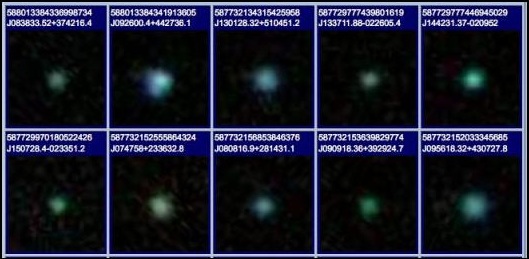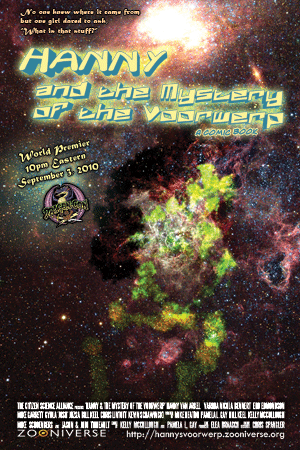Green Pea galaxies were discovered by participants in Galaxy Zoo, which grew out of the need to provide more help to astronomers with a huge number of night sky images produced by the Sloan Digital Sky Survey.
These citizen scientists discovered a strange type of galaxy that did not fit with previously known types. Small in size and green in color, they were soon named "Green Pea" galaxies. They appear to be compact low-mass galaxies undergoing intense star formation, and being around 1.5 to 5 billion years distant indicates that this is a brief but extreme stage of their evolution.

A selection of Green Pea galaxies discovered by the Galaxy Zoo citizen scientists. Credit: Richard Nowell.
Green Pea galaxies are now known to be "metal-poor"; metals in this astronomical sense meaning any element other than hydrogen and helium. A study on Green Pea galaxies was presented Friday at the Joint European and National Astronomy Meeting (JENAM2010) by Ricardo Amorin which suggested that gas gravitationally attracted from the outskirts of the Green Pea galaxies or beyond, combined with shock waves from supernova explosions, are likely causes. Amorin said, “Discovering Green Pea galaxies has opened a new window to investigate galaxy evolution and star formation in the early Universe.”
Green Pea galaxies aren’t the only citizen science successes to come from Galaxy Zoo. In 2007, Dutch school teacher Hanny van Arkel was categorizing galaxies for the project when she came across a very strange object. This was soon named Hanny’s Voorwerp, from the Dutch for “Hanny’s Object”. This strange phenomenon baffled scientists, and it was only in June 2010 that a possible explanation was provided – a supermassive blackhole in a nearby galaxy emitting radiation and making a cloud of gas glow. The community of amateur astronomers have cooperated to make an educational webcomic about this adventure, called “Hanny and the Mystery of the Voorwerp”.

Amorin concludes, “The Galaxy Zoo volunteers have put science very close to the citizens. This is an active and powerful way to spread science.”
The latest incarnation of Galaxy Zoo uses data provided by the famous Hubble Space Telescope, to peer deeper into the Universe than before.
More on results from JENAM 2010 in Portugal.






Comments